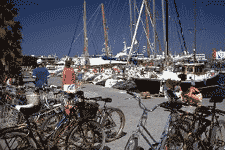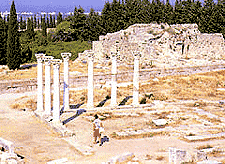The third largest island in the Dodecanese, after Rhodes and Karpathos, Kos lies between Kalimnos and Nissiros. It is mainly flat with a mountain chain-Mts. Dikeos (875 m.) and Simpatras running along the south coast.Famous as the birthplace of Hippocrates, the father of medicine, Kos is also known for its lovely, gentle scenery. nhabited since prehistoric times, Kos, like Rhodes and the other Dodecanese, has known periods of great prosperity but also times of great hardship over the centuries. During the Mycenaean period (15th -12th century B.C.), the island was densely settled and took part in the Trojan War. In the 7th and 6th century B.C., it was the sixth city-state along with Halicarnassus, Knidos, Lindos, Ialyssos and Kameiros in the Dorian hexapolis.  After the end of the Persian Wars it became a member of the First Delian or Athenian Confederacy. The teaching of Hippocrates (467-357 B.C.) and the founding of the new city of Kos (366 B.C.) marked an important milestone in the history of the island, which by the fourth century B.C. had become one of the most powerful maritime and trading powers in the Eastern Mediterranean. It also flourished during the Hellenistic period under the Ptolemies of Egypt whence the ancient saying "they could feed neither Kos nor Egypt", equating its prosperity with that of the fabled land of the Nile.In the 2nd century A.D., however, Kos fell under the sway of Rome and sank into obscurity.
After the end of the Persian Wars it became a member of the First Delian or Athenian Confederacy. The teaching of Hippocrates (467-357 B.C.) and the founding of the new city of Kos (366 B.C.) marked an important milestone in the history of the island, which by the fourth century B.C. had become one of the most powerful maritime and trading powers in the Eastern Mediterranean. It also flourished during the Hellenistic period under the Ptolemies of Egypt whence the ancient saying "they could feed neither Kos nor Egypt", equating its prosperity with that of the fabled land of the Nile.In the 2nd century A.D., however, Kos fell under the sway of Rome and sank into obscurity.
 It is a beautiful town, set amidst abundant greenery. Most of the town is of recent origin. Nevertheless, it also boasts some well-preserved Venetian buildings, the castle of the Knights which overlooks the harbour, as well as extensive Hellenistic and Roman ruins.
It is a beautiful town, set amidst abundant greenery. Most of the town is of recent origin. Nevertheless, it also boasts some well-preserved Venetian buildings, the castle of the Knights which overlooks the harbour, as well as extensive Hellenistic and Roman ruins.The present town, whose development has been based on a carefully studied land use plan, is characterized by flower-filled squares lined by impressive buildings and broad, shaded streets.Further embellished by clusters of palm trees, the town's streets are enlivened by thousands of bicycles - the locals' favorite means of transport. Kos is the centre of life on the island in every way. Most of its hotels, tourist facilities, restaurants and nightclubs are concentrated here, along with a wide variety of shops and boutiques.
Other things worth seeing round the town include Hippocrates' Plane Tree, said to have been planted by the father of medicine and under whose shade tradition maintains that he taught; it is considered the oldest tree in Europe.The Venetian Castle of the Knights (15th century), a splendid example of the imposing military architecture of the age. The Loggia, a two-storey building of the 18th century with an elegant minaret towering over it,both constructed with materials taken from the ancient site. The Archaeological Museum, containing finds from the Classical, Hellenistic and Roman eras, including a 4th century B.C. statue of Hippocrates.The famous Asklepieion is situated some 4 kilometres from Kos town in a wooded area overlooking the sea. Its building commenced after the death of Hippocrates in the mid 4th century B.C.Because of the sloping terrain, the sanctuary is constructed on three terraces, which are joined by a magnificent staircase. The first terrace formed a kind of courtyard and was surrounded by colonnades. According to accounts of the time, various ceremonies and festivals were conducted here and it may have housed the medical school. The second terrace was dominated by the Great Altar, while the majestic Doric temple of Asklepius (2nd c. B.C.) rests on the third. The sculptures that adorned the sanctuary buildings were master pieces.Kos could also form a base for visiting other islands in the vicinity, such as worldly, sophisticated Rhodes, or less well known places, off the beaten path.Kos if famous for the beautiful beaches. One of the best beaches starts from the south end of the city and continues for about 2 km.Other beaches are, Tigaki, Marmari, Mastihari, Kardamena, Agios Stefanos and Kamari.

